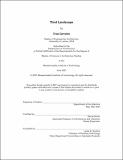Third Landscape
Author(s)
Carmeliet, Dries
DownloadThesis PDF (258.4Mb)
Advisor
Ghosn, Rania
Terms of use
Metadata
Show full item recordAbstract
The global energy sector accounts for over 60 percent of all greenhouse gas emissions. The aim of this research is to investigate the agency of bottom-up approaches and local initiatives to build energy projects with renewable technologies. The greatest challenge these projects face are their enormous spatial requirement. Externalizing these technologies to remote locations, like oceans and deserts where land is easily available, significantly increases the cost of power and the siting difficulties of the accompanying large-scale transmission infrastructures. By internalizing energy production into populated landscapes, renewable technologies not only are more cost-effective, but can become important drivers for local economies as well. To unlock the potential of such bottom-up strategies for energy projects, a radical shift from established practices is needed. At its core, the energy transition requires a cultural change. It demands a process of negotiation between existing natural and human landscapes, and the need for productive energy landscapes. This research is scalar in nature and takes the U.S. Northeast, Massachusetts, and two municipalities in Massachusetts as case-studies. The premise of these bottom-up strategies is to move beyond climate action as a moral obligation, and instead search for a new form of climate action that is based on a series values shared by communities, like the access to clean water, to unpolluted air, to well-paid jobs, and to affordable power. Hence, this transition requires new co-location and co-habitation models. This research therefore calls for a “third landscape” that is neither technological or natural, but both at the same time. To build such a landscape, seven shifts in how energy projects should be approached are proposed: (1) Energy production should shift from sites external to populated areas, to sites within them; (2) Energy planning should shift from top-down, developer-led approaches that maximize profits, to bottom-up approaches of local government-led projects that forward sustainability; (3) Energy land-use should shift from monofunctional zones to multifunctional landscapes; (4) Energy agendas should shift from human agendas that push cheap power, to environmental agendas that prioritize sustainability; (5) Energy design should shift from technological, engineering-optimized methodologies to spatial approaches that include urban and natural agendas; (6) Energy economies should shift from linear ‘take-make-waste’ systems to circular economies that engage local residents in their construction, operation, and value chains; (7) Energy transmission should shift from a loose to a strong regional cohesion, using landscape features for their siting.
Date issued
2021-06Department
Massachusetts Institute of Technology. Department of ArchitecturePublisher
Massachusetts Institute of Technology